Punjabi language
Punjabi (Gurmukhi: ਪੰਜਾਬੀ, Shahmukhi: پن٘جابی /pʌnˈdʒɑːbi/;[6] Punjabi pronunciation: [pənˈdʒaːbːi]; sometimes spelled Panjabi) is an Indo-Aryan language with more than 125 million native speakers in the Indian subcontinent and around the world. It is the native language of the Punjabi people, an ethnolinguistic group of the cultural region of Punjab, which encompasses northwest India and eastern Pakistan.
| Punjabi | |
|---|---|
| ਪੰਜਾਬੀ, پن٘جابی | |
 'Punjabi' written in Shahmukhi used in Punjab, Pakistan (top) and Gurmukhi used in Punjab, India (bottom) scripts | |
| Pronunciation |
|
| Native to | India, Pakistan |
| Region | Punjab |
| Ethnicity | Punjabis |
Native speakers | 125 million (2011–2015)[1] |
Indo-European
| |
| Dialects |
|
| |
| Official status | |
Official language in | |
| Language codes | |
| ISO 639-1 | pa |
| ISO 639-2 | pan |
| ISO 639-3 | Either:pan – Panjabipnb – Western Panjabi |
| Glottolog | panj1256 Eastern Panjabi[4]west2386 Western Panjabi[5] |
| Linguasphere | 59-AAF-e |
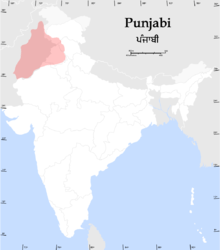 Areas of the Indian Subcontinent where Punjabi is natively spoken | |
| Part of a series on the |
| Punjabis |
|---|
 |
|
|
Asia
Europe North America Oceania |
|
Culture |
|
Punjab portal |
Punjabi is the most widely spoken language in Pakistan,[7] the 11th most widely spoken language in India and the third most-spoken native language in the Indian subcontinent. It is the third most spoken language in the United Kingdom after the native British languages and Polish.[8] It is also the fifth most-spoken native language in Canada after English, French, Mandarin and Cantonese. It is the twenty-sixth most spoken language in the United States, and tenth in Australia.[9]
Punjabi is unusual among Indo-European languages in its use of lexical tone;[10][11][12] see § Tone below for examples. Gurmukhi is the official script for the language in Punjab, India while Shahmukhi is used in Punjab, Pakistan; other national and local scripts have also been in use historically and currently, as discussed in § Writing systems.
History
Etymology
The word Punjabi (sometimes spelled Panjabi) has been derived from the word Panj-āb, Persian for 'Five Waters', referring to the five major eastern tributaries of the Indus River. The name of the region was introduced by the Turko-Persian conquerors[13] of South Asia and was a translation of the Sanskrit name for the region, Panchanada, which means 'Land of the Five Rivers'.[14][15]
Panj is cognate with Sanskrit pañca (पञ्च), Greek pénte (πέντε), and Lithuanian Penki, all of which meaning 'five'; āb is cognate with Sanskrit áp (अप्) and with the Av- of Avon. The historical Punjab region, now divided between India and Pakistan, is defined physiographically by the Indus River and these five tributaries. One of the five, the Beas River, is a tributary of another, the Sutlej.
Origin
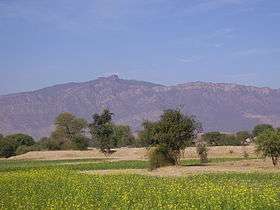
Punjabi developed from Prakrit languages and later Apabhraṃśa (Sanskrit: अपभ्रंश, 'corruption' or 'corrupted speech')[16] From 600 BC, Sanskrit was advocated as official language and Prakrit gave birth to many regional languages in different parts of India. All these languages are called Prakrit (Sanskrit: प्राकृत, prākṛta) collectively. Paishachi Prakrit was one of these Prakrit languages, which was spoken in north and north-western India and Punjabi developed from this Prakrit. Later in northern India Paishachi Prakrit gave rise to Paishachi Aparbhsha, a descendant of Prakrit.[17] Punjabi emerged as an Apabhramsha, a degenerated form of Prakrit, in the 7th century A.D. and became stable by the 10th century.
Arabic and Persian influence on Punjabi
The Arabic and modern-Persian influence in the historical Punjab region began with the late first millennium Muslim conquests on the Indian subcontinent.[18] Many Persian and Arabic words were incorporated in Punjabi.[19][20] It is noteworthy that the Hindustani language is divided into Hindi, with more Sanskritisation, and Urdu, with more Persianisation, but in Punjabi Sanskrit usage is less and Punjabi relies heavily on Persian and Arabic words are used with a liberal approach to language. Most important words in Punjabi, like ਅਰਦਾਸ and ਰਹਿਰਾਸ, and common words, like ਨਹਿਰ, ਜ਼ਮੀਨ, ਗਜ਼ਲ, etc., have all come out of Persian.
In fact, the sounds of ਜ਼, ਖ਼, ਸ਼, and ਫ਼ have been borrowed from Persian. Later, it was lexically influenced by Portuguese (words like ਅਲਮਾਰੀ), Greek (words like ਦਾਮ), Chagatai (words like ਕੈਂਚੀ, ਸੁਗਾਤ), Japanese (words like ਰਿਕਸ਼ਾ), Chinese (words like ਚਾਹ, ਲੀਚੀ, ਲੁਕਾਠ) and English (words like ਜੱਜ, ਅਪੀਲ, ਮਾਸਟਰ), though these influences have been minor in comparison to Persian and Arabic.[21]
| English | Gurmukhi-based (Punjab, India) | Shahmukhi-based (Punjab, Pakistan) |
|---|---|---|
| President | ਰਾਸ਼ਟਰਪਤੀ (rāshtarpatī) | صدرمملکت (sadar-e mumlikat) |
| Article | ਲੇਖ (lēkh) | مضمون (mazmūn) |
| Prime Minister | ਪਰਧਾਨ ਮੰਤਰੀ (pardhān mantarī)* | وزیراعظم (wazīr-e aʿzam) |
| Family | ਪਰਿਵਾਰ (parivār)* ਟੱਬਰ (ṭabbar) ਲਾਣਾ (lāṇā) |
خاندان (kḥāndān) ٹبّر (ṭabbar) |
| Philosophy | ਫ਼ਲਸਫ਼ਾ (falsafā) ਦਰਸ਼ਨ (darshan) |
فلسفہ (falsafā) |
| Capital (seat of government) | ਰਾਜਧਾਨੀ (rājdhānī) | دارالحکومت (dārul hakūmat) |
| Viewer | ਦਰਸ਼ਕ (darshak) | ناظرین (nāzarīn) |
| Listener | ਸਰੋਤਾ (sarotā) | سامع (sāma') |
Note: In more formal contexts, hypercorrect Sanskritized versions of these words (ਪ੍ਰਧਾਨ pradhān for ਪਰਧਾਨ pardhān and ਪਰਿਵਾਰ parivār for ਪਰਵਾਰ parvār) may be used.
Modern times
Punjabi is spoken in many dialects in an area from Delhi to Islamabad. The Majhi dialect has been adopted as standard Punjabi in India and Pakistan for education, media etc. The Majhi dialect originated in the Majha region of the Punjab. The Majha region consists of several eastern districts of Pakistani Punjab and in India around Amritsar, Gurdaspur, and surrounding districts. The two most important cities in this area are Lahore and Amritsar.
In India, Punjabi is written in the Gurmukhī script in offices, schools, and media. Gurmukhi is the official standard script for Punjabi, though it is often unofficially written in the Latin scripts due to influence from English, India's two primary official languages at the Union-level.
In Pakistan, Punjabi is generally written using the Shahmukhī script, created from a modification of the Persian Nastaʿlīq script. In Pakistan, Punjabi loans technical words from Persian and Arabic languages, just like Urdu does.
Geographic distribution
Punjabi is the most widely spoken language in Pakistan, the eleventh -most widely spoken in India and spoken Punjabi diaspora in various countries.
Pakistan
Punjabi is the most widely spoken language in Pakistan, being the native language of 44% of its population. It is the provincial language in the Punjab Province.
| Year | Population of Pakistan | Percentage | Punjabi speakers |
|---|---|---|---|
| 1951 | 33,740,167 | 57.08% | 22,632,905 |
| 1961 | 42,880,378 | 56.39% | 28,468,282 |
| 1972 | 65,309,340 | 56.11% | 43,176,004 |
| 1981 | 84,253,644 | 48.17% | 40,584,980 |
| 1998 | 132,352,279 | 44.15% | 58,433,431 |
Beginning with the 1981 census, speakers of Saraiki and Hindko were no longer included in the total numbers for Punjabi, which could explain the apparent decrease.
India
Punjabi is spoken as a native language by about 33 million people in India. Punjabi is the official language of the Indian state of Punjab. It is additional official in Haryana and Delhi. Some of its major urban centres in northern India are Amritsar, Ludhiana, Chandigarh, Jalandhar, Ambala, Patiala, Bathinda, Hoshiarpur and Delhi.
| Year | Population of India | Punjabi speakers in India | Percentage |
|---|---|---|---|
| 1971 | 548,159,652 | 14,108,443 | 2.57% |
| 1981 | 665,287,849 | 19,611,199 | 2.95% |
| 1991 | 838,583,988 | 23,378,744 | 2.79% |
| 2001 | 1,028,610,328 | 29,102,477 | 2.83% |
| 2011 | 1,210,193,422 | 33,124,726 | 2.74% |
Punjabi diaspora

Punjabi is also spoken as a minority language in several other countries where Punjabi people have emigrated in large numbers, such as the United States, Australia, the United Kingdom, and Canada, where it is the fourth-most-commonly used language.[24] There were 76 million Punjabi speakers in Pakistan in 2008,[25] 33 million in India in 2011,[26] 0.7 million in Canada in 2016,[27] 0.3 million in the United States[28] and smaller numbers in other countries.
Major dialects
Majhi (Standard Punjabi)
The Majhi dialect spoken around Amritsar and Lahore is Punjabi's prestige dialect. Majhi is spoken in the heart of Punjab in the region of Majha, which spans Lahore, Amritsar, Gurdaspur, Kasur, Tarn Taran, Faisalabad, Nankana Sahib, Pathankot, Okara, Pakpattan, Sahiwal, Narowal, Sheikhupura, Sialkot, Gujranwala and Gujrat districts. Punjabi official language based on the Majhi.
Majhi retains the nasal consonants /ŋ/ and /ɲ/, which have been superseded elsewhere by non-nasals /ɡ/ and /d͡ʒ/ respectively.
Shahpuri
Shahpuri dialect (also known as Sargodha dialect) is mostly spoken in Pakistani Punjab. Its name is derived from former Shahpur District (now Shahpur Tehsil, being part of Sargodha District). It is spoken throughout a widespread area, spoken in Sargodha and Khushab Districts and also spoken in neighbouring Mianwali and Bhakkar Districts. It is mainly spoken on western end of Indus River to Chenab river crossing Jhelum river.[29]
Malwai
Malwai is spoken in the southern part of Indian Punjab and also in Bahawalnagar and Vehari districts of Pakistan. Main areas are faridkot, Barnala, Ludhiana, Patiala, Ambala, Bathinda, Mansa, Sangrur, Malerkotla, Fazilka, Ferozepur, Moga. Malwa is the southern and central part of present-day Indian Punjab. It also includes the Punjabi speaking northern areas of Haryana, viz. Ambala, Panchkula etc. Not to be confused with the Malvi language, which shares its name.
Doabi
Doabi is spoken in both the Indian Punjab as well as parts of Pakistan Punjab owing to post-1947 migration of Muslim populace from East Punjab. The word "Do Aabi" means "the land between two rivers" and this dialect was historically spoken between the rivers of the Beas and the Sutlej in the region called Doaba. Regions it is presently spoken in include the Jalandhar, Hoshiarpur and Kapurthala districts in Indian Punjab, specifically in the areas known as the Dona and Manjki, as well as the Toba Tek Singh and Faisalabad districts in Pakistan Punjab where the dialect is known as Faisalabadi Punjabi.
Puadhi
Puadh is a region of Punjab and parts of Haryana between the Satluj and Ghaggar rivers. The part lying south, south-east and east of Rupnagar adjacent to Ambala District (Haryana) is Puadhi. The Puadh extends from that part of the Rupnagar District which lies near Satluj to beyond the Ghaggar river in the east up to Kala Amb, which is at the border of the states of Himachal Pradesh and Haryana. Parts of Fatehgarh Sahib district, and parts of Patiala districts like Rajpura are also part of Puadh. The Puadhi dialect is spoken over a large area in present Punjab as well as Haryana. In Punjab, Kharar, Kurali, Ropar, Nurpurbedi, Morinda, Pail, Rajpura and Samrala are areas where Puadhi is spoken and the dialect area also includes Pinjore, Kalka, Ismailabad, Pehowa to Bangar area in Fatehabad district.
Jatki/Jangli/Rachnavi
Jatki or Jangli is a dialect of native tribes of areas whose names are often suffixed with Bar derived from jungle bar before irrigation system arrived in the start of the 20th century, for example, Sandal Bar, Kirana Bar, Neeli Bar, Ganji Bar. Native people called their dialect as Jatki instead of Jangli.
Jatki dialect is mostly spoken by Indigenous peoples of Faisalabad, Jhang, Toba Tek Singh, Chiniot, Nankana Sahib, Hafizabad, Mandi Bahauddin, Sargodha, Sahiwal, Okara, Pakpattan, Bahawalnagar, Vehari, and Khanewal districts of Pakistani Punjab. It is also spoken in few areas of Sheikhupura, Muzaffargarh, Lodhran' Bahawalpur, and Fazilka districts of Indian Punjab.
Jhangochi/Jhangvi
Jhangochi, spoken in Khanewal and Jhang districts, is a subdialect of Jatki/Jangli. The word Jhangochi has limitations as it doesn't represent whole bar region of Punjab.
Chenavari
West of Chenab River in Jhang District of Pakistani Punjab, the dialect of Jhangochi merges with Thalochi and resultant dialect is Chenavari, which derives its name from the river.
Phonology
While a vowel length distinction between short and long vowels exists, reflected in modern Gurmukhi orthographical conventions, it is secondary to the vowel quality contrast between centralised vowels /ɪ ə ʊ/ and peripheral vowels /iː eː ɛː aː ɔː oː uː/ in terms of phonetic significance.[30]
| Front | Near-front | Central | Near-back | Back | |
|---|---|---|---|---|---|
| Close | iː ਈ اِی | uː ਊ اُو | |||
| Near-close | ɪ ਇ اِ | ʊ ਉ اُ | |||
| Close-mid | eː ਏ اے | oː ਓ او | |||
| Mid | ə ਅ اَ | ||||
| Open-mid | ɛː ਐ اَے | ɔː ਔ اَو | |||
| Open | aː ਆ آ |
The peripheral vowels have nasal analogues.[31]
| Labial | Dental/ Alveolar |
Retroflex | Palatal | Velar | Glottal | ||
|---|---|---|---|---|---|---|---|
| Nasal | m ਮ م | n ਨ ن | ɳ ਣ ݨ | ɲ ਞ ن | ŋ ਙ ن٘ | ||
| Stop/ Affricate |
tenuis | p ਪ پ | t ਤ ت | ʈ ਟ ٹ | t͡ʃ ਚ چ | k ਕ ک | |
| aspirated | pʰ ਫ پھ | tʰ ਥ تھ | ʈʰ ਠ ٹھ | t͡ʃʰ ਛ چھ | kʰ ਖ کھ | ||
| voiced | b ਬ ب | d ਦ د | ɖ ਡ ڈ | d͡ʒ ਜ ج | ɡ ਗ گ | ||
| Fricative | voiceless | (f ਫ਼ ف) | s ਸ س | ʃ ਸ਼ ش | (x ਖ਼ خ) | ||
| voiced | (z ਜ਼ ز) | (ɣ ਗ਼ غ) | ɦ ਹ ہ | ||||
| Rhotic | ɾ~r ਰ ر | ɽ ੜ ڑ | |||||
| Approximant | ʋ ਵ و | l ਲ ل | ɭ ਲ਼ لؕ[32] | j ਯ ی | |||
The three retroflex consonants /ɳ ɽ ɭ/ do not occur initially, and the nasals /ŋ ɲ/ occur only as allophones of /n/ in clusters with velars and palatals. The well-established phoneme /ʃ/ may be realised allophonically as the voiceless retroflex fricative /ʂ/ in learned clusters with retroflexes. The phonemic status of the fricatives /f z x ɣ/ varies with familiarity with Hindustani norms, with the pairs /f pʰ/, /z d͡ʒ/, /x kʰ/, and /ɣ g/ systematically distinguished in educated speech.[33] The retroflex lateral is most commonly analysed as an approximant as opposed to a flap.[34][35][36]
Tone
Punjabi is a tonal language and in many words there is a choice of up to three tones, high-falling, low-rising, and level (neutral):[37][38][39]
| Gurmukhi | Shahmukhi | Transliteration | Tone | Meaning |
|---|---|---|---|---|
| ਘਰ | گھر | kàr | high-falling | house |
| ਕਰ੍ਹ | کرھ | kár | low-rising | dandruff |
| ਕਰ | کر | kar | level | do |
| ਘੋੜਾ | گھوڑا | kòṛā | high-falling | horse |
| ਕੋੜ੍ਹਾ | کوڑھا | kóṛā | low-rising | leper |
| ਕੋੜਾ | کوڑا | kōṛā | level | whip |
Level tone is found in about 75% of words and is described by some as absence of tone.[37] There are also some words which are said to have rising tone in the first syllable and falling in the second. (Some writers describe this as a fourth tone.)[37] However, a recent acoustic study of six Punjabi speakers in the United States found no evidence of a separate falling tone following a medial consonant.[40]
- ਮੋਢਾ / موڈھا, móḍà (rising-falling), "shoulder"
It is considered that these tones arose when voiced aspirated consonants (gh, jh, ḍh, dh, bh) lost their aspiration. At the beginning of a word they became voiceless unaspirated consonants (k, c, ṭ, t, p) followed by a high-falling tone; medially or finally they became voiced unaspirated consonants (g, j, ḍ, d, b), preceded by a low-rising tone. (The development of a high-falling tone apparently did not take place in every word, but only in those which historically had a long vowel.)[39]
The presence of an [h] (although the [h] is now silent or very weakly pronounced except word-initially) word-finally (and sometimes medially) also often causes a rising tone before it, for example cá(h) "tea".[41]
The Gurmukhi script which was developed in the 16th century has separate letters for voiced aspirated sounds, so it is thought that the change in pronunciation of the consonants and development of tones may have taken place since that time.[39]
Some other languages in Pakistan have also been found to have tonal distinctions, including Burushaski, Gujari, Hindko, Kalami, Shina, and Torwali.[42]
Grammar
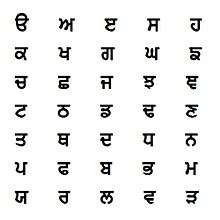
Punjabi has a canonical word order of SOV (subject–object–verb).[43] It has postpositions rather than prepositions.[44]
Punjabi distinguishes two genders, two numbers, and five cases of direct, oblique, vocative, ablative, and locative/instrumental. The ablative occurs only in the singular, in free variation with oblique case plus ablative postposition, and the locative/instrumental is usually confined to set adverbial expressions.[45]
Adjectives, when declinable, are marked for the gender, number, and case of the nouns they qualify.[46] There is also a T-V distinction. Upon the inflectional case is built a system of particles known as postpositions, which parallel English's prepositions. It is their use with a noun or verb that is what necessitates the noun or verb taking the oblique case, and it is with them that the locus of grammatical function or "case-marking" then lies. The Punjabi verbal system is largely structured around a combination of aspect and tense/mood. Like the nominal system, the Punjabi verb takes a single inflectional suffix, and is often followed by successive layers of elements like auxiliary verbs and postpositions to the right of the lexical base.[47]
The grammar of the Punjabi language concerns the word order, case marking, verb conjugation, and other morphological and syntactic structures of the Punjabi language.
Writing systems
| Shahmukhi alphabet |
|---|
| ا ب پ ت ٹ ث ج چ ح خ د ڈ ذ ر ڑ ز ژ س ش ص ض ط ظ ع غ ف ق ک گ ل لؕ م ن ݨ (ں) و ه (ھ) ء ی ے |
|
Extended Perso-Arabic script |
|
The Punjabi language is written in multiple scripts (a phenomenon known as synchronic digraphia). Each of the major scripts currently in use is typically associated with a particular religious group,[48][49] although the association is not absolute or exclusive.[50] In India, Punjabi Sikhs use Gurmukhi, a script of the Brahmic family, which has official status in the state of Punjab. In Pakistan, Punjabi Muslims use Shahmukhi, a variant of the Perso-Arabic script and closely related to the Urdu alphabet. The Punjabi Hindus in India had a preference for Devanagari, another Brahmic script also used for Hindi, and in the first decades since independence raised objections to the uniform adoption of Gurmukhi in the state of Punjab,[51] but most have now switched to Gurmukhi[52] and so the use of Devanagari is rare.[53]
Historically, various local Brahmic scripts including Laṇḍā and its descendants were also in use.[53][54]
The Punjabi Braille is used by the visually impaired.
Sample text
This sample text was taken from the Punjabi Wikipedia article on Lahore.
ਲਹੌਰ ਪਾਕਿਸਤਾਨੀ ਪੰਜਾਬ ਦੀ ਰਾਜਧਾਨੀ ਹੈ। ਲੋਕ ਗਿਣਤੀ ਦੇ ਨਾਲ ਕਰਾਚੀ ਤੋਂ ਬਾਅਦ ਲਹੌਰ ਦੂਜਾ ਸਭ ਤੋਂ ਵੱਡਾ ਸ਼ਹਿਰ ਹੈ। ਲਹੌਰ ਪਾਕਿਸਤਾਨ ਦਾ ਸਿਆਸੀ, ਰਹਤਲੀ ਅਤੇ ਪੜ੍ਹਾਈ ਦਾ ਗੜ੍ਹ ਹੈ ਅਤੇ ਇਸੇ ਲਈ ਇਹਨੂੰ ਪਾਕਿਸਤਾਨ ਦਾ ਦਿਲ ਵੀ ਕਿਹਾ ਜਾਂਦਾ ਹੈ। ਲਹੌਰ ਰਾਵੀ ਦਰਿਆ ਦੇ ਕੰਢੇ 'ਤੇ ਵਸਦਾ ਹੈ। ਇਸਦੀ ਲੋਕ ਗਿਣਤੀ ਇੱਕ ਕਰੋੜ ਦੇ ਨੇੜੇ ਹੈ|
لہور پاکستانی پن٘جاب دا دارالحکومت ہے۔ لوک گݨتی دے نالؕ کراچی توں بعد لہور دوجا سبھ توں وڈا شہر ہے۔ لہور پاکستان دا سیاسی، رہتلی اتے پڑھائی دا گڑھ ہے اتے، اسے لئی ایھنوں پاکستان دا دل وی کیھا جاندا ہے۔ لہور راوی دریا دے کݨڈھے تے وسدا ہے۔ اسدی لوک گݨتی اک کروڑ دے نیڑے ہے۔
lahaur pākistānī panjāb dī rājtā̀ni/dārul hakūmat ài. lok giṇtī de nāḷ karācī tõ bāad lahaur dūjā sáb tõ vaḍḍā šáir ài. lahaur pākistān dā siāsī, rátalī ate paṛā̀ī dā gáṛ ài te ise laī ínū̃ pākistān dā dil vī kihā jāndā ài. lahaur rāvī dariā de káṇḍè te vasdā ài. isdī lok giṇtī ikk karoṛ de neṛe ài.
[ləɦɔːɾᵊ paːkɪstaːniː pənd͡ʒaːbᵊ diː ɾaːd͡ʒᵊtàːni: / daːɾəl hʊkuːmət ɦɛ̀ː ‖ lo:kᵊ ɡɪɳᵊtiː de naːlᵊ kəɾaːt͡ʃiː tõ: baːədᵊ ləɦɔːɾᵊ duːd͡ʒaː sə́bᵊ tõ: ʋəɖːaː ʃəɦɪɾ ɦɛ̀ː ‖ ləɦɔːɾᵊ paːkɪstaːnᵊ daː sɪaːsiː | ɾə́ɦtəliː əte: pəɽàːiː daː ɡə́ɽ ɦɛ̀ː əte: ɪse: ləiː ɪ́ɦnū̃ paːkɪstaːnᵊ daː dɪlᵊ ʋiː kɪɦaː d͡ʒa:ndaː ɛ̀ː ‖ ləɦɔːɾᵊ ɾaːʋiː dəɾɪa: de: kə́ɳɖe: te: ʋəsᵊdaː ɛ̀ː ‖ ɪsᵊdiː lo:kᵊ ɡɪɳᵊtiː ɪkːᵊ kəɾo:ɽᵊ de: ne:ɽe: ɛ̀ː ‖]
Lahore is the capital city of Pakistani Punjab. After Karachi, Lahore is the second largest city. Lahore is Pakistan's political, cultural, and educational hub, and so it is also said to be the heart of Pakistan. Lahore lies on the bank of the Ravi River. Its population is close to ten million people.
Literature development
Medieval era, Mughal and Sikh period
- The earliest Punjabi literature is found in the fragments of writings of the 11th century Nath yogis Gorakshanath and Charpatnah which is primarily spiritual and mystical in tone.
- Fariduddin Ganjshakar (1179-1266) is generally recognised as the first major poet of the Punjabi language.[55] Roughly from the 12th century to the 19th century, many great Sufi saints and poets preached in the Punjabi language, the most prominent being Bulleh Shah. Punjabi Sufi poetry also developed under Shah Hussain (1538–1599), Sultan Bahu (1630–1691), Shah Sharaf (1640–1724), Ali Haider (1690–1785), Waris Shah (1722–1798), Saleh Muhammad Safoori (1747-1826), Mian Muhammad Baksh (1830-1907) and Khwaja Ghulam Farid (1845-1901).
- The Sikh religion originated in the 15th century in the Punjab region and Punjabi is the predominant language spoken by Sikhs.[56] Most portions of the Guru Granth Sahib use the Punjabi language written in Gurmukhi, though Punjabi is not the only language used in Sikh scriptures.
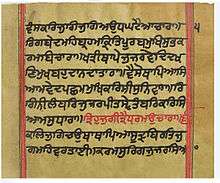
The Janamsakhis, stories on the life and legend of Guru Nanak (1469–1539), are early examples of Punjabi prose literature.
- The Punjabi language is famous for its rich literature of qisse, most of the which are about love, passion, betrayal, sacrifice, social values and a common man's revolt against a larger system. The qissa of Heer Ranjha by Waris Shah (1706–1798) is among the most popular of Punjabi qissas. Other popular stories include Sohni Mahiwal by Fazal Shah, Mirza Sahiban by Hafiz Barkhudar (1658–1707), Sassui Punnhun by Hashim Shah (c. 1735–c. 1843), and Qissa Puran Bhagat by Qadaryar (1802–1892).
- Heroic ballads known as Vaar enjoy a rich oral tradition in Punjabi. Famous Vaars are Chandi di Var (1666–1708), Nadir Shah Di Vaar by Najabat and the Jangnama of Shah Mohammad (1780–1862).[57]
British Raj era and post-independence period
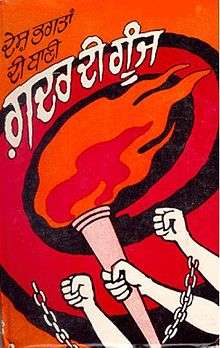
The Victorian novel, Elizabethan drama, free verse and Modernism entered Punjabi literature through the introduction of British education during the Raj. Nanak Singh (1897–1971), Vir Singh, Ishwar Nanda, Amrita Pritam (1919–2005), Puran Singh (1881–1931), Dhani Ram Chatrik (1876–1957), Diwan Singh (1897–1944) and Ustad Daman (1911–1984), Mohan Singh (1905–78) and Shareef Kunjahi are some legendary Punjabi writers of this period. After independence of Pakistan and India Najm Hossein Syed, Fakhar Zaman and Afzal Ahsan Randhawa, Shafqat Tanvir Mirza, Ahmad Salim, and Najm Hosain Syed, Munir Niazi, Pir Hadi Abdul Mannan enriched Punjabi literature in Pakistan, whereas Amrita Pritam (1919–2005), Jaswant Singh Rahi (1930–1996), Shiv Kumar Batalvi (1936–1973), Surjit Patar (1944–) and Pash (1950–1988) are some of the more prominent poets and writers from India.
Status
Despite Punjabi's rich literary history, it was not until 1947 that it would be recognised as an official language. Previous governments in the area of the Punjab had favoured Persian, Hindustani, or even earlier standardised versions of local registers as the language of the court or government. After the annexation of the Sikh Empire by the British East India Company following the Second Anglo-Sikh War in 1849, the British policy of establishing a uniform language for administration was expanded into the Punjab. The British Empire employed Urdu in its administration of North-Central and Northwestern India, while in the North-East of India, Bengali language was used as the language of administration. Despite its lack of official sanction, the Punjabi language continued to flourish as an instrument of cultural production, with rich literary traditions continuing until modern times. The Sikh religion, with its Gurmukhi script, played a special role in standardising and providing education in the language via Gurdwaras, while writers of all religions continued to produce poetry, prose, and literature in the language.
In India, Punjabi is one of the 22 scheduled languages of India. It is the first official language of the Indian State of Punjab. Punjabi also has second language official status in Delhi along with Urdu, and in Haryana. In Pakistan, no regional ethnic language has been granted official status at the national level, and as such Punjabi is not an official language at the national level, even though it is the most spoken language in Pakistan after Urdu, the national language of Pakistan. It is, however, the official provincial language of Punjab, Pakistan, the second largest and the most populous province of Pakistan as well as in Islamabad Capital Territory. The only two official national languages in Pakistan are Urdu and English, which are considered the lingua francas of Pakistan.
In Pakistan
When Pakistan was created in 1947, although Punjabi was the majority language in West Pakistan and Bengali the majority in East Pakistan and Pakistan as whole, English and Urdu were chosen as the national languages. The selection of Urdu was due to its association with South Asian Muslim nationalism and because the leaders of the new nation wanted a unifying national language instead of promoting one ethnic group's language over another. Broadcasting in Punjabi language by Pakistan Broadcasting Corporation decreased on TV and radio after 1947. Article 251 of the Constitution of Pakistan declares that these two languages would be the only official languages at the national level, while provincial governments would be allowed to make provisions for the use of other languages.[58] However, in the 1950s the constitution was amended to include the Bengali language. Eventually, Punjabi was granted status as a provincial language in Punjab Province, while the Sindhi language was given official status in 1972 after 1972 Language violence in Sindh.
Despite gaining official recognition at the provincial level, Punjabi is not a language of instruction for primary or secondary school students in Punjab Province (unlike Sindhi and Pashto in other provinces).[59] Pupils in secondary schools can choose the language as an elective, while Punjabi instruction or study remains rare in higher education. One notable example is the teaching of Punjabi language and literature by the University of the Punjab in Lahore which began in 1970 with the establishment of its Punjabi Department.[60][61]
In the cultural sphere, there are many books, plays, and songs being written or produced in the Punjabi-language in Pakistan. Until the 1970s, there were a large number of Punjabi-language films being produced by the Lollywood film industry, however since then Urdu has become a much more dominant language in film production. Additionally, television channels in Punjab Province (centred on the Lahore area) are broadcast in Urdu. The preeminence of Urdu in both broadcasting and the Lollywood film industry is seen by critics as being detrimental to the health of the language.[62][63]
The use of Urdu and English as the near exclusive languages of broadcasting, the public sector, and formal education have led some to fear that Punjabi in Pakistan is being relegated to a low-status language and that it is being denied an environment where it can flourish. Several prominent educational leaders, researchers, and social commentators have echoed the opinion that the intentional promotion of Urdu and the continued denial of any official sanction or recognition of the Punjabi language amounts to a process of "Urdu-isation" that is detrimental to the health of the Punjabi language[64][65][66] In August 2015, the Pakistan Academy of Letters, International Writer’s Council (IWC) and World Punjabi Congress (WPC) organised the Khawaja Farid Conference and demanded that a Punjabi-language university should be established in Lahore and that Punjabi language should be declared as the medium of instruction at the primary level.[67][68] In September 2015, a case was filed in Supreme Court of Pakistan against Government of Punjab, Pakistan as it did not take any step to implement the Punjabi language in the province.[69][70] Additionally, several thousand Punjabis gather in Lahore every year on International Mother Language Day. Thinktanks, political organisations, cultural projects, and individuals also demand authorities at the national and provincial level to promote the use of the language in the public and official spheres.[71][72][73]
In India
At the federal level, Punjabi has official status via the Eighth Schedule to the Indian Constitution,[74] earned after the Punjabi Suba movement of the 1950s.[75] At the state level, Punjabi is the sole official language of the state of Punjab, while it has secondary official status in the states of Haryana and Delhi.[76] In 2012, it was also made additional official language of West Bengal in areas where the population exceeds 10% of a particular block, sub-division or district.[3]
Both federal and state laws specify the use of Punjabi in the field of education. The state of Punjab uses the Three Language Formula, and Punjabi is required to be either the medium of instruction, or one of the three languages learnt in all schools in Punjab.[77] Punjabi is also a compulsory language in Haryana,[78] and other states with a significant Punjabi speaking minority are required to offer Punjabi medium education.
There are vibrant Punjabi language movie and news industries in India, however Punjabi serials have had a much smaller presence within the last few decades in television due to market forces.[79] Despite Punjabi having far greater official recognition in India, "where the Punjabi language is officially admitted in all necessary social functions, while in Pakistan it is used only in a few radio and TV programs," attitudes of the English-educated elite towards the language are ambivalent as they are in neighbouring Pakistan.[74]:37 There are also claims of state apathy towards the language in non-Punjabi majority areas like Haryana and Delhi.[80][81][82]
Advocacy
- Punjabi University was established on 30 April 1962, and is only the second university in the world to be named after a language, after Hebrew University of Jerusalem. The Research Centre for Punjabi Language Technology, Punjabi University, Patiala.[83] It is working for development of core technologies for Punjabi, Digitisation of basic materials, online Punjabi teaching, developing software for office use in Punjabi, providing common platform to Punjabi cyber community.[84] Punjabipedia, an online encyclopaedia was also launched by Patiala university in 2014.[85][86]
- The Dhahan Prize was created award literary works produced in Punjabi around the world. The Prize encourages new writing by awarding $25,000 CDN annually to one "best book of fiction" published in either of the two Punjabi scripts, Gurmukhi or Shahmukhi. Two second prizes of $5,000 CDN are also awarded, with the provision that both scripts are represented among the three winners. The Dhahan Prize is awarded by Canada India Education Society (CIES).[87]
Governmental academies and institutes
The Punjabi Sahit academy, Ludhiana, established in 1954[88][89] is supported by the Punjab state government and works exclusively for promotion of the Punjabi language, as does the Punjabi academy in Delhi.[90] The Jammu and Kashmir academy of art, culture and literature[91] in Jammu and Kashmir UT, India works for Punjabi and other regional languages like Urdu, Dogri, Gojri etc. Institutions in neighbouring states[92] as well as in Lahore, Pakistan[93] also advocate for the language.
 Punjabi Sahit academy, Ludhiana,1954
Punjabi Sahit academy, Ludhiana,1954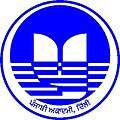 Punjabi academy, Delhi,1981-1982
Punjabi academy, Delhi,1981-1982 Jammu and Kashmir academy of art, culture and literature
Jammu and Kashmir academy of art, culture and literature Pilac(Punjab Institute of Language, Art and Culture, Lahore,2004
Pilac(Punjab Institute of Language, Art and Culture, Lahore,2004
Software
- Software are available for Punjabi language for almost all platforms. These software are mainly in Gurmukhi script. Nowadays, nearly all Punjabi newspapers, magazines, journals, and periodicals are composed on computers via various Punjabi software programmes, the most widespread of which is InPage Desktop Publishing package. Microsoft has included Punjabi language support in all new versions of Windows and both Windows Vista, Mircrsoft Office 2007, 2010 and 2013, are available in Punjabi through the Language Interface Pack[94] support. Most Linux Desktop distributions allow the easy installation of Punjabi support and translations as well.[95] Apple implemented the Punjabi language keyboard across Mobile devices.[96] Google also provides many applications in Punjabi, like Google Search,[97] Google Translate[98] and Google Punjabi Input Tools.[99]
Gallery
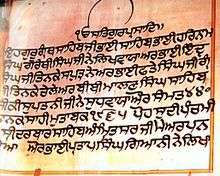 Guru Granth Sahib in Gurmukhi
Guru Granth Sahib in Gurmukhi Punjabi Gurmukhi script
Punjabi Gurmukhi script- Punjabi Shahmukhi script
 Bhulay Shah poetry in Punjabi (Shahmukhi script)
Bhulay Shah poetry in Punjabi (Shahmukhi script)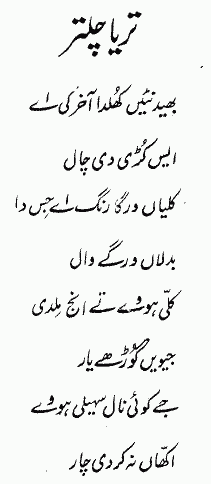 Munir Niazi poetry in Punjabi (Shahmukhi script)
Munir Niazi poetry in Punjabi (Shahmukhi script)_138.jpg) Gurmukhi alphabet
Gurmukhi alphabet
See also
- Punjabi Wikipedia
- Languages of Pakistan
- Languages of India
- List of Indian languages by total speakers
- List of Punjabi-language newspapers
- Hindi-to-Punjabi Machine Translation System
- Punjabi cinema
Notes
- "Punjabi, Eastern". Ethnologue. Retrieved 23 December 2018. "Punjabi, Western". Ethnologue. Retrieved 23 December 2018. Figure taken by combining total users of Punjabi, Eastern and Punjabi, Western in all countries.
- "NCLM 52nd Report" (PDF). NCLM. 15 November 2016. Archived from the original (PDF) on 15 November 2016. Retrieved 13 January 2020.
- "Multi-lingual Bengal". The Telegraph. 11 December 2012. Archived from the original on 25 March 2018. Retrieved 25 March 2018.
- Hammarström, Harald; Forkel, Robert; Haspelmath, Martin, eds. (2017). "Eastern Panjabi". Glottolog 3.0. Jena, Germany: Max Planck Institute for the Science of Human History.
- Hammarström, Harald; Forkel, Robert; Haspelmath, Martin, eds. (2017). "Western Panjabi". Glottolog 3.0. Jena, Germany: Max Planck Institute for the Science of Human History.
- Laurie Bauer, 2007, The Linguistics Student's Handbook, Edinburgh
- "Pakistan Census". Census.gov.pk. Archived from the original on 12 September 2011. Retrieved 4 January 2014.
- https://www.mirror.co.uk/news/uk-news/2011-census-top-20-languages-1563629
- Hindi is the top Indian language spoken in Australia, SBS, 26 October 2018.
- Bhatia, Tej (1999). "Lexican Anaphors and Pronouns in Punjabi". In Lust, Barbara; Gair, James (eds.). Lexical Anaphors and Pronouns in Selected South Asian Languages. Walter de Gruyter. p. 637. ISBN 978-3-11-014388-1. Other tonal Indo-Aryan languages include Lahnda and Western Pahari.
- Phonemic Inventory of Punjabi Archived 16 July 2015 at the Wayback Machine
- Geeti Sen. Crossing Boundaries. Orient Blackswan, 1997. ISBN 978-81-250-1341-9. Page 132. Quote: "Possibly, Punjabi is the only major South Asian language that has this kind of tonal character. There does seem to have been some speculation among scholars about the possible origin of Punjabi's tone-language character but without any final and convincing answer..."
- Canfield, Robert L. (1991). Persia in Historical Perspective. Cambridge, United Kingdom: Cambridge University Press. p. 1 ("Origins"). ISBN 978-0-521-52291-5.
- Sir, Yule, Henry (13 August 2018). "Hobson-Jobson: A glossary of Colloquial Anglo-Indian Words and Phrases, and of Kindred Terms, Etymological, Historical, Geographical and Discursive". dsalsrv02.uchicago.edu.
- Macdonell, Arthur Anthony (13 August 2018). "A Practical Sanskrit Dictionary with Transliteration, Accentuation, and Etymological Analysis Throughout".
- .https://books.google.com/books?id=gqIbJz7vMn0C&pg=PA166&dq=punjabi+prakrit+language&hl=en&sa=X&ved=0ahUKEwie9PGZnrzQAhXMtI8KHay-AfwQ6AEIKTAD#v=onepage&q=punjabi%20prakrit%20language&f=false Archived 21 January 2017 at the Wayback Machine
- G S Sidhu (2004). Panjab And Panjabi.
- Brard, G.S.S. (2007). East of Indus: My Memories of Old Punjab. Hemkunt Publishers. p. 81. ISBN 9788170103608. Archived from the original on 9 February 2018. Retrieved 13 January 2017.
- Mir, F. (2010). The Social Space of Language: Vernacular Culture in British Colonial Punjab. University of California Press. p. 35. ISBN 9780520262690. Archived from the original on 9 February 2018. Retrieved 13 January 2017.
- Schiffman, H. (2011). Language Policy and Language Conflict in Afghanistan and Its Neighbors: The Changing Politics of Language Choice. Brill. p. 314. ISBN 9789004201453. Archived from the original on 9 February 2018. Retrieved 13 January 2017.
- Menon, A.S.; Kusuman, K.K. (1990). A Panorama of Indian Culture: Professor A. Sreedhara Menon Felicitation Volume. Mittal Publications. p. 87. ISBN 9788170992141. Archived from the original on 9 February 2018. Retrieved 13 January 2017.
- "Archived copy". Archived from the original on 26 September 2009. Retrieved 17 September 2009.CS1 maint: archived copy as title (link)
- "Growth of Scheduled Languages-1971, 1981, 1991 and 2001". Census of India. Ministry of Home Affairs, Government of India. Archived from the original on 20 February 2015. Retrieved 22 February 2015.
- "Punjabi is 4th most spoken language in Canada". The Times of India. 14 February 2008. Archived from the original on 14 November 2016.
- Pakistan 1998 census – Population by mother tongue Archived 17 February 2006 at the Wayback Machine
- "Indian Census". Censusindia.gov.in. Archived from the original on 6 February 2012. Retrieved 4 January 2014.
- "Census Profile, 2016 Census, Canada". Government of Canada, Statistics Canada. 8 February 2017. Retrieved 11 August 2020.
- "US survey puts Punjabi speakers in US at 2.8 lakh". Times of India. 18 December 2017. Retrieved 11 August 2020.
- "The Art and Culture of the Diaspora | Mother Tongue: The Many Dialects of Punjabi". Sikhchic.com. Retrieved 2 February 2016.
- Shackle 2003, p. 587.
- Shackle 2003, p. 588.
- ArLaam (similar to ArNoon) has been added to Unicode since Unicode 13.0.0, which can be found in Unicode Arabic Extended-A 08C7, PDF Pg 73 under “Arabic Letter for Punjabi” 08C7 : ࣇ ARABIC LETTER LAM WITH SMALL ARABIC LETTER TAH ABOVE
- Shackle 2003, p. 589.
- Masica 1991, p. 97.
- Arora, K. K.; Arora, S.; Singla, S. R.; Agrawal, S. S. (2007). "SAMPA for Hindi and Punjabi based on their Acoustic and Phonetic Characteristics". Proceedings Oriental COCOSDA: 4–6.
- Ladefoged, Peter; Maddieson, Ian (1996). The Sounds of the World's Languages. Oxford: Blackwell. pp. 190–191. ISBN 978-0631198154.
- Bailey, T.Grahame (1919), English-Punjabi Dictionary, introduction.
- Singh, Sukhvindar, "Tone Rules and Tone Sandhi in Punjabi".
- Bowden, A.L. (2012). "Punjabi Tonemics and the Gurmukhi Script: A Preliminary Study".
- Kanwal, J.; Ritchart, A.V (2015) "An experimental investigation of tonogenesis in Punjabi". Proceedings of the 18th International of Phonetic Sciences, 2015
- Lata, Swaran; Arora, Swati (2013) "Laryngeal Tonal characteristics of Punjabi: An Experimental Study"
- Baart, J.L.G. "Tonal features in languages of northern Pakistan"
- Gill, Harjeet Singh and Gleason Jr, Henry A. (1969). A Reference Grammar of Panjabi. Patiala: Department of Linguistics, Punjabi University
- "WALS Online - Language Panjabi". wals.info.
- Shackle (2003:599)
- Shackle (2003:601)
- Masica (1991:257)
- Bhatia 2008, p. 128.
- Bhardwaj 2016, pp. 12–13.
- Jain 2003, pp. 53, 57–8.
- Nayar 1966, pp. 46 ff.
- Bhardwaj 2016, p. 12.
- Shackle 2003, p. 594.
- Bhardwaj 2016, p. 15.
- Shiv Kumar Batalvi Archived 10 April 2003 at the Wayback Machine sikh-heritage.co.uk.
- Melvin Ember; Carol R. Ember; Ian A. Skoggard, eds. (2005). Encyclopedia of Diasporas: Immigrant and Refugee Cultures Around the World. Springer. p. 1077. ISBN 978-0-306-48321-9.
- The Encyclopaedia of Indian Literature (Volume One - A to Devo). Volume 1. Amaresh Datta, ed. Sahitya Akademi: 2006, 352.
- "Chapter 4: "General." of Part XII: "Miscellaneous"". pakistani.org. Archived from the original on 3 June 2014. Retrieved 30 December 2016.
- Zaidi, Abbas. "Linguistic cleansing: the sad fate of Punjabi in Pakistan". Archived from the original on 29 October 2016.
- University of the Punjab (2015), "B.A. Two-Year (Pass Course) Examinations"
- "University of the Punjab - Examinations". pu.edu.pk. Archived from the original on 8 February 2017. Retrieved 13 January 2017.
- University of the Punjab (2015). "Department of Punjabi". Archived from the original on 27 November 2016.
- Masood, Tariq (21 February 2015). "The colonisation of language". The Express Tribune. Archived from the original on 12 September 2015. Retrieved 19 September 2015.
- Warraich, Faizan; Ali, Haider (15 September 2015). "Intelligentsia urges govt to promote Punjabi language". DailyTimes. Archived from the original on 30 June 2015. Retrieved 15 September 2015.
- "Punjabis Without Punjabi". apnaorg.com. Archived from the original on 25 May 2017. Retrieved 13 January 2017.
- "Inferiority complex declining Punjabi language: Punjab University Vice-Chancellor". PPI News Agency
- "Inferiority complex declining Punjabi language: Punjab University Vice-Chancellor | Pakistan Press International". ppinewsagency.com. Archived from the original on 27 November 2016. Retrieved 13 January 2017.
- "Urdu-isation of Punjab - The Express Tribune". The Express Tribune. 4 May 2015. Archived from the original on 27 November 2016. Retrieved 30 December 2016.
- "Rally for ending 150-year-old 'ban on education in Punjabi". The Nation. 21 February 2011. Archived from the original on 7 March 2016. Retrieved 15 September 2015.
- "Sufi poets can guarantee unity". The Nation. 26 August 2015. Archived from the original on 30 October 2015.
- "Supreme Court's Urdu verdict: No language can be imposed from above". The Nation. 15 September 2015. Archived from the original on 16 September 2015. Retrieved 15 September 2015.
- "Two-member SC bench refers Punjabi language case to CJP". Business Recorder. 14 September 2015. Archived from the original on 21 October 2015. Retrieved 15 September 2015.
- "Mind your language—The movement for the preservation of Punjabi". The Herald. 2 September 2106.
- "Mind your language—The movement for the preservation of Punjabi - People & Society - Herald". herald.dawn.com. 4 August 2016. Archived from the original on 23 December 2016. Retrieved 13 January 2017.
- "Punjabi in schools: Pro-Punjabi outfits in Pakistan threaten hunger strike". The Times of India. 4 October 2015.
- "Punjabi in schools: Pro-Punjabi outfits in Pakistan threaten hunger strike - Times of India". timesofindia.indiatimes.com. Archived from the original on 27 September 2016. Retrieved 13 January 2017.
- "Rally for Ending the 150 year-old Ban on Education in Punjabi" The Nation. 21 February 2011.
- "Rally for ending 150-year-old 'ban on education in Punjabi". nation.com.pk. 21 February 2011. Archived from the original on 7 March 2016. Retrieved 13 January 2017.
- Khokhlova, Liudmila (January 2014). "Majority Language Death" (PDF). Language Endangerment and Preservation in South Asia. Archived (PDF) from the original on 25 May 2017. Retrieved 29 April 2017.
Punjabi was nonetheless included in the Eighth Schedule of the Constitution of India and came to be recognized as one of the fifteen official languages of the country.
- "Fifty Years of Punjab Politics (1920-70)". Panjab Digital Library. Retrieved 6 January 2019.
- Ayres, Alyssa (2008). "Language, the Nation, and Symbolic Capital: The Case of Punjab" (PDF). The Journal of Asian Studies. 67 (3): 917–946. doi:10.1017/S0021911808001204. Archived (PDF) from the original on 25 May 2017. Retrieved 28 April 2017.
in India, Punjabi is an official language as well as the first language of the state of Punjab (with secondary status in Delhi and widespread use in Haryana).
- Kumar, Ashutosh (2004). "Electoral Politics in Punjab: Study of Akali Dal". Economic & Political Weekly. 39 (14/15): 1515–1520. JSTOR 4414869.
Punjabi was made the first compulsory language and medium of instruction in all the government schools whereas Hindi and English as second and third language were to be implemented from the class 4 and 6 respectively
- 52nd Report of the Commissioner for Linguistic Minorities in India (PDF) (Report). National Commission on Linguistic Minorities. 2015. p. 25. Archived from the original (PDF) on 25 May 2017. Retrieved 28 April 2017.
Languages taught in the State under the Three Language Formula: First Language : Hindi Second Language : Punjabi Third language : English
- Singh, Jasmine (13 September 2015). "Serial killer". The Tribune. Archived from the original on 16 September 2015. Retrieved 15 September 2015.
- "SGPC claims Haryana govt ignoring Punjabi language". Hindustan Times. 30 July 2015. Retrieved 15 September 2015.
- Aujla, Harjap Singh (15 June 2015). "Punjabi's of Delhi couldn't get justice for Punjabi language". Punjab News Express. Retrieved 19 September 2015.
- Singh, Perneet (9 July 2013). "Sikh bodies oppose DU's 'anti-Punjabi' move". Tribune India. Retrieved 21 February 2018.
- "final". punjabiuniversity.ac.in. Archived from the original on 24 November 2016. Retrieved 13 January 2017.
- "ACTDPL, Punjabi University, Patiala". learnpunjabi.org. Archived from the original on 10 December 2016. Retrieved 13 January 2017.
- "ਪੰਜਾਬੀ ਪੀਡੀਆ". punjabipedia.org. Archived from the original on 21 December 2016. Retrieved 13 January 2017.
- "Pbi University launches Punjabipedia | punjab | Hindustan Times". Hindustan Times. 26 February 2014. Archived from the original on 23 November 2016. Retrieved 13 January 2017.
- "The Dhahan Prize | The Dhahan Prize for Punjabi Literature". dhahanprize.com. Archived from the original on 27 February 2017. Retrieved 13 January 2017.
- "ਪੰਜਾਬੀ ਲੇਖਕਾਂ ਦਾ ਮੱਕਾ : ਪੰਜਾਬੀ ਭਵਨ, ਲੁਧਿਆਣਾ". 3 May 2017. Archived from the original on 3 May 2017. Retrieved 16 October 2017.
- "Sirsa again elected Punjabi Sahit Akademi president". Tribuneindia.com. 18 April 2016. Retrieved 13 August 2018.
- "Punjabi Academy". www.punjabiacademy.com. Archived from the original on 18 July 2017.
- http://jkculture.nic.in/seminars.htm# Archived 23 November 2016 at the Wayback Machine
- "पंजाबी सीखने वाले छात्रों को अगले माह बटेगा एकल प्रोत्साहन राशि". M.livehindustan.com. 24 October 2016. Retrieved 13 August 2018.
- "Welcome to Punjab Institute of Language, Art & Culture | Punjab Institute of Language, Art & Culture". pilac.punjab.gov.pk. Archived from the original on 11 July 2017.
- "Microsoft Download Center". microsoft.com. Archived from the original on 23 November 2016. Retrieved 13 January 2017.
- "Punjabi Linux (punlinux) download | SourceForge.net". sourceforge.net. Archived from the original on 23 November 2016. Retrieved 13 January 2017.
- "Connecting to the iTunes Store". itunes.apple.com. Archived from the original on 23 November 2016. Retrieved 13 January 2017.
- "Google". Retrieved 13 January 2017.
- "Google ਅਨੁਵਾਦ". Archived from the original on 29 December 2016. Retrieved 13 January 2017.
- "Cloud ਇਨਪੁਟ ਔਜ਼ਾਰ ਔਨਲਾਈਨ ਅਜਮਾਓ – Google ਇਨਪੁਟ ਔਜ਼ਾਰ". Archived from the original on 12 January 2017. Retrieved 13 January 2017.
References
- Bhardwaj, Mangat Rai (2016), Panjabi: A Comprehensive Grammar, Routledge, doi:10.4324/9781315760803, ISBN 9781138793859.
- Bhatia, Tej K. (2008), "Major regional languages", in Braj B. Kachru; Yamuna Kachru; S.N. Sridhar (eds.), Language in South Asia, Cambridge University Press, pp. 121–131, doi:10.1017/CBO9780511619069.008, ISBN 9780511619069.
- Grierson, George A. (1916). Linguistic Survey of India. Volume IX: Indo-Aryan family. Central group, Part 1, Specimens of western Hindi and Pañjābī. Calcutta: Office of the Superintendent of Government Printing, India.
- Jain, Dhanesh (2003), "Sociolinguistics of the Indo-Aryan Languages", in Cardona, George; Jain, Dhanesh (eds.), The Indo-Aryan Languages, Routledge, pp. 46–66, ISBN 978-0-415-77294-5.
- Masica, Colin (1991), The Indo-Aryan Languages, Cambridge: Cambridge University Press, ISBN 978-0-521-29944-2.
- Nayar, Baldev Raj (1966), Minority Politics in the Punjab, Princeton University Press, ISBN 9781400875948.
- Shackle, Christopher (2003), "Panjabi", in Cardona, George; Jain, Dhanesh (eds.), The Indo-Aryan Languages, Routledge, pp. 581–621, ISBN 978-0-415-77294-5.
Further reading
- Bhatia, Tej. 1993 and 2010. Punjabi : a cognitive-descriptive grammar. London: Routledge. Series: Descriptive grammars.
- Gill H.S. [Harjit Singh] and Gleason, H.A. 1969. A reference grammar of Punjabi. Revised edition. Patiala, Punjab, India: Languages Department, Punjab University.
- Chopra, R. M., Perso-Arabic Words in Punjabi, in: Indo-Iranica Vol.53 (1–4).
- Chopra, R. M.., The Legacy of The Punjab, 1997, Punjabee Bradree, Calcutta.
- Singh, Chander Shekhar (2004). Punjabi Prosody: The Old Tradition and The New Paradigm. Sri Lanka: Polgasowita: Sikuru Prakasakayo.
- Singh, Chander Shekhar (2014). Punjabi Intonation: An Experimental Study. Muenchen: LINCOM EUROPA.
External links
| Wikibooks has a book on the topic of: Punjabi |
| Wikimedia Commons has media related to Punjabi language. |
| Eastern Punjabi edition of Wikipedia, the free encyclopedia |
| Western Punjabi edition of Wikipedia, the free encyclopedia |